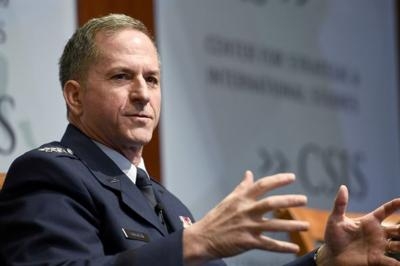Remarks Made Before The Senate Armed Services Committee Earlier This Month
Secretary of the Air Force Heather Wilson and Chief of Staff of the Air Force Gen. David L. Goldfein thanked Congress for providing the resources necessary to restore the service’s readiness while testifying before the Senate Armed Services Committee’s Subcommittee on Readiness and Management Support Oct. 10.

During her testimony, Wilson (pictured) praised Congress for passing an appropriations bill on time for the first time in nearly a decade. “With your help, we have made great strides in a short period of time,” she said. “We are more ready today than we were two years ago.”
After decades of readiness decline, the Air Force is working to accelerate its recovery, ensuring the service is prepared to combat rapidly evolving threats.
Today more than 75 percent of the Air Force’s core fighting units are combat ready with their lead forces packages. The service’s goal is for 80 percent of those units to have the right number of properly trained and equipped Airmen by the end of 2020 – 6 years faster than projected before the Air Force developed a recovery plan. “Restoring the readiness of the force is our top priority.” Goldfein said. “And the budget Congress recently passed will have a significant impact for Airmen across our active, guard, and reserve components.”
To do this the Air Force is focusing on three key areas: people, training and cost-effective maintenance and logistics.
For the Air Force, readiness is first and foremost about people. In fiscal year 2018, Congress provided funding to allow the Air Force to address a serious shortage of maintainers. In September 2016, the service was short 4,000 active duty maintainers, but by December 2018 that number is expected to reach zero. “Actions by Congress over the last few years has been tremendously helpful,” Wilson said. “Now we must get these Airmen the experience needed to become craftsman at their work.”
In addition to maintainers, the Air Force has placed an emphasis on addressing the national aircrew shortage, first by addressing quality of service and quality of life issues, and also increasing financial incentives and providing more control over assignments and career paths.
The Air Force is increasing the number of pilots it trains from 1,160 a year in FY 2017 to 1,311 in FY 2019, building to 1,500 by FY 2022 and steady state, thereafter.
As part of the readiness recovery, the Air Force is focused on providing relevant and realistic training to maintain an advantage over increasingly capable adversaries. To meet this need the service is investing in operational training infrastructure — ranges and airspace — and simulation.
The Air Force is also improving infrastructure, simulators, threat emulators and training ranges to enhance realism and enable Airmen to train locally for a high-end, multi-domain fight.

The third element of restoring the readiness of the force is weapons system sustainment – the parts, supply and equipment – to make sure our aircraft are ready to go when needed. “There are a thousand fingerprints on every aircraft that takes off. From air traffic control to crew chiefs to weapons loaders to avionics technicians – it is a total team effort,” Goldfein (pictured) said. “When the plane is twice the age of the team, it makes it harder. So we are looking at new methods across the board for how we are maintaining an older fleet with a younger workforce.”
The Air Force is already seeing improvements in its depots, increasing depot production by 20 percent, completing 75 aircraft per year.
(Source: USAF news release. Images from file)
 Airbus Racer Helicopter Demonstrator First Flight Part of Clean Sky 2 Initiative
Airbus Racer Helicopter Demonstrator First Flight Part of Clean Sky 2 Initiative Diamond's Electric DA40 Finds Fans at Dübendorf
Diamond's Electric DA40 Finds Fans at Dübendorf ANN's Daily Aero-Term (04.23.24): Line Up And Wait (LUAW)
ANN's Daily Aero-Term (04.23.24): Line Up And Wait (LUAW) NTSB Final Report: Extra Flugzeugbau GMBH EA300/L
NTSB Final Report: Extra Flugzeugbau GMBH EA300/L Classic Aero-TV: 'Never Give Up' - Advice From Two of FedEx's Female Captains
Classic Aero-TV: 'Never Give Up' - Advice From Two of FedEx's Female Captains




